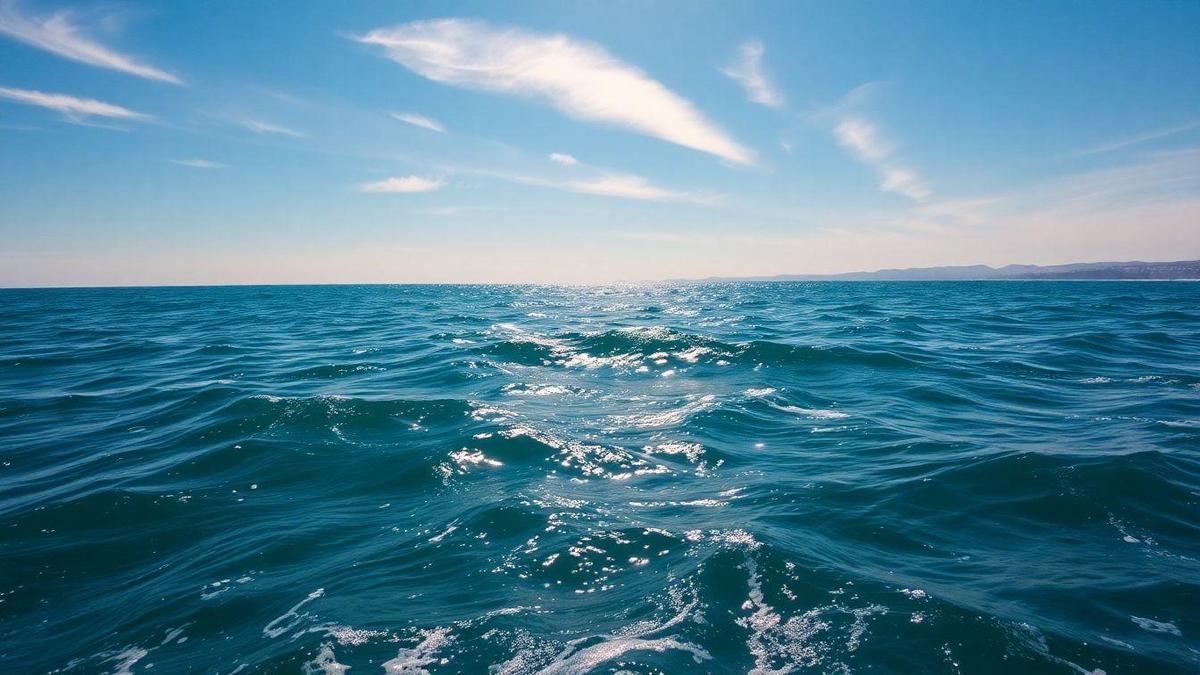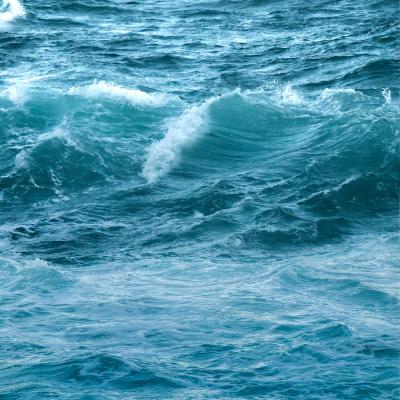Anúncios
Ocean currents play a crucial role in regulating global climate, responsible for the redistribution of heat and nutrients around the planet. They are driven by a combination of factors, such as winds, the Earth’s rotation, and variations in water temperature and salinity. These ocean flows form a complex and dynamic network, whose understanding is essential for predicting climate events and preserving marine ecosystems.
The dynamics of ocean currents are also closely linked to global warming, with possible changes in circulation patterns due to the melting of polar ice caps and changes in ocean salinity. Understanding these processes can provide crucial information on how climate change affects climate and marine biodiversity. This study is fundamental for mitigation and adaptation policies necessary to face global environmental challenges.
Anúncios

How Ocean Currents Influence Global Climate
Ocean currents are essential for regulating global climate by transporting large volumes of heat. They mainly move through prevailing winds and are influenced by variations in temperature and salinity. This movement of warm water from the tropics to higher latitudes has the power to moderate the climate of distant regions, such as Western Europe.
One of the most well-known currents is the Gulf Stream, which transports warm water across the Atlantic Ocean. This current has a significant impact on atmospheric temperature and climatic conditions in the region. Changes in the functioning of these currents can therefore result in extreme weather events and changes in precipitation patterns.
Moreover, ocean currents play a role in transporting heat to the poles, helping balance global temperatures. With global warming, there is growing concern about how these currents may be altered, leading to abrupt climate changes and affecting marine ecosystems.
Finally, the interaction of ocean currents with the atmosphere can create climate patterns that influence weather in various parts of the world. This includes the formation of phenomena such as El Niño and La Niña, which have a significant impact on agriculture, precipitation patterns, and the occurrence of natural disasters.
The Importance of Thermohaline Circulation for Global Climate
Thermohaline circulation, or the “global conveyor belt,” is a crucial part of ocean currents. This circulation system is driven by differences in temperature and salinity in seawater. It regulates the distribution of heat across the oceans by moving warm water from tropical regions to the polar zones and vice versa.
With the rise in global temperatures, there is an increasing risk of disturbing this circulation system. The melting of polar ice caps can dilute the salinity of the water and alter its density, affecting deep water flow and the effectiveness of the thermohaline system. This can result in drastic changes in global climate and conditions of marine ecosystems.
Additionally, thermohaline circulation also has an important impact on the distribution of nutrients and essential gases in the oceans. The movement of deep water to the surface, known as upwelling, brings important nutrients to sustain marine life. Disruptions in this process could compromise the health of ocean ecosystems.
Changes in thermohaline circulation can also affect regional climate patterns. Alterations in the flow of ocean currents can change atmospheric conditions, resulting in extreme weather events, such as stronger hurricanes or prolonged droughts in certain regions.
The Impact of Ocean Currents on Marine Communities

Ocean currents are vital for the transport of nutrients and oxygen essential for marine life. The upwelling of deep waters brings a large amount of nutrients to the surface, sustaining rich biodiversity in the ocean. This directly affects fishing and coastal economies that depend on these resources.
However, changes in ocean currents, driven by global warming and other climate changes, can disrupt these processes. Alterations in the temperature and salinity of the oceans can reduce the efficiency of upwelling, affecting nutrient availability and impacting marine food chains.
Moreover, ocean currents play an important role in the distribution of marine organisms. They help spread different species of fish, plankton, and other organisms across vast areas. If the currents change, this may affect the distribution of species and even lead to the collapse of entire marine ecosystems.
Preserving ocean currents is therefore essential to ensure the health of marine ecosystems. Studies on the dynamics of these currents can help develop more effective conservation policies, protecting both biodiversity and human communities that depend on the ocean for their livelihoods.
Changes in Ocean Currents and Their Effects on Agriculture
Ocean currents directly influence climate patterns that affect agriculture. For example, the Gulf Stream has a moderating effect on the climate of Western Europe, resulting in milder temperatures. Changes in these currents can therefore lead to variations in agricultural seasons and affect food production.
With global warming, changes in ocean currents may alter precipitation and temperature patterns, affecting crops. Areas that depend on seasonal rainfall may experience a reduction or increase in these patterns, affecting agricultural production and food security.
Furthermore, changes in ocean currents can influence climatic phenomena such as prolonged droughts or intense flooding. This can lead to greater volatility in crop yields, creating challenges for farmers worldwide. Adapting to these changes will be essential to ensure food security.
The study of ocean currents and their effects on climate can help develop more resilient agricultural strategies. By understanding how changes in the oceans affect the climate, it is possible to predict and mitigate negative impacts on agriculture.
Mitigation and Adaptation Strategies for Changes in Ocean Currents

Given the importance of ocean currents for global climate, it is essential to develop mitigation strategies to address the impacts of climate change. Reducing greenhouse gas emissions can help decrease global warming and avoid drastic changes in ocean currents.
Additionally, adapting to changes in ocean currents is crucial. This includes implementing coastal management policies to protect communities vulnerable to the effects of climate change, such as sea level rise and extreme weather events. International cooperation is essential to effectively address these challenges.
Another important strategy is continuous monitoring of ocean currents. This will allow scientists to identify early changes in currents and their impacts on the climate, helping develop faster and more effective preventive measures. Collaborative research is crucial for understanding how ocean currents can be managed.
Finally, marine conservation policies also play a crucial role in adapting to changes in ocean currents. Protecting marine ecosystems and reducing pollution can help increase the resilience of the oceans and the communities that depend on them.
How Ocean Currents Work
The dynamics of ocean currents are a critical aspect of Earth’s climate system, influencing everything from climate patterns to marine ecosystems. These currents are large-scale flows of seawater, driven by various factors, including wind, the Earth’s rotation, and differences in water density. The interaction of these forces creates a complex network of currents circulating through the world’s oceans. Understanding how these currents work is essential for understanding their impact on global climate.
The main drivers of ocean currents include wind patterns, which generate surface currents, and thermohaline circulation, which refers to deep-water currents driven by differences in temperature and salinity. Surface currents, such as the Gulf Stream, are mainly influenced by wind and can transport warm water from the tropics to higher latitudes. In contrast, thermohaline circulation operates on a much larger scale, involving the sinking of cold, dense water in polar regions and the subsequent upwelling of warmer water in other areas. This global conveyor belt of ocean circulation plays a crucial role in regulating Earth’s climate.
Additionally, ocean currents are influenced by the Earth’s rotation, which causes the Coriolis effect. This effect alters the direction of currents, causing them to curve instead of flowing in a straight line. For example, currents in the Northern Hemisphere tend to veer to the right, while those in the Southern Hemisphere veer to the left. This rotational influence, combined with factors such as landmasses and ocean basin shapes, creates a complex system of currents that interact with each other.
The dynamics of ocean currents are not static; they can change over time due to various factors, including climate change. As global temperatures rise, the melting of ice caps and changes in salinity can alter the density of seawater, potentially destabilizing established current patterns. Understanding these dynamics is vital for predicting future climate scenarios and assessing potential impacts on marine life and coastal communities.
Did You Enjoy Learning About the Dynamics of Ocean Currents and Their Influence on Global Climate?
Understanding thermohaline circulation helps explain how ocean currents regulate the climate.
The role of ocean heat distribution is crucial for predicting regional climate changes.
Upwelling and sinking processes significantly impact marine ecosystems.
Ocean circulation patterns influence global climate systems and extreme events.
Changes in ocean currents may disrupt nutrient distribution, affecting fisheries.
Collaborative research on ocean currents enhances global climate action efforts.
In conclusion, understanding the dynamics of ocean currents is vital for grasping their influence on global climate and marine ecosystems. By studying these currents, we gain valuable insights into climate prediction, marine biodiversity, and effective climate action strategies. The interaction between ocean currents and climate is complex but essential for ensuring a sustainable future.
Frequently Asked Questions
What are ocean currents?
Ocean currents are movements of water in the oceans. They move because of wind, temperature, and salinity.
How do ocean currents affect the climate?
Ocean currents transport heat. This influences air temperature and can change the climate in various parts of the world.
What is the relationship between ocean currents and global warming?
Global warming can change ocean currents. This, in turn, affects global climate, bringing more extreme weather events.
Why are ocean currents important for marine life?
Currents help transport nutrients and oxygen. This is essential for maintaining healthy and diverse marine life.
What are some examples of well-known ocean currents?
Some well-known currents are the Gulf Stream and the Humboldt Current. They have a significant impact on the regions where they are located.
